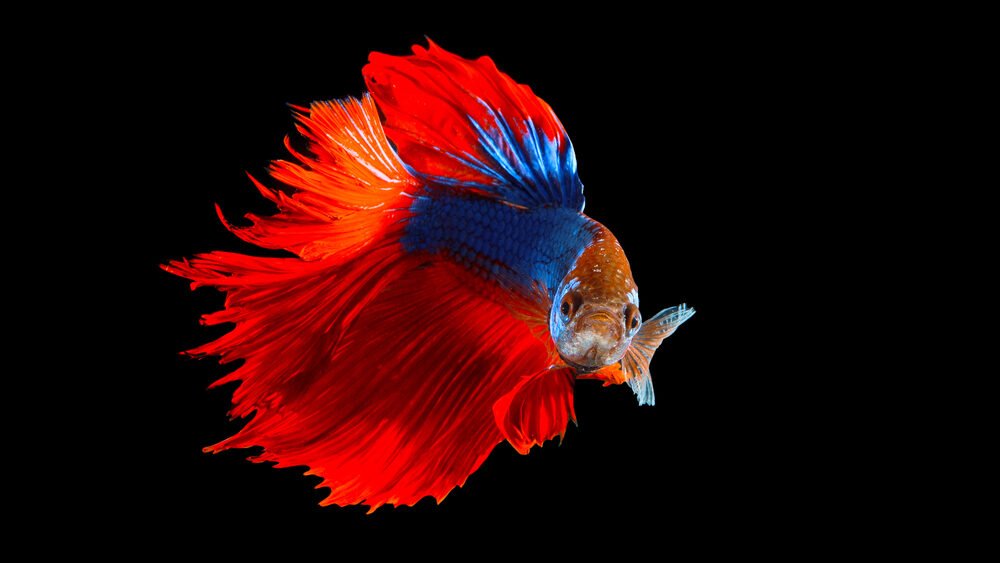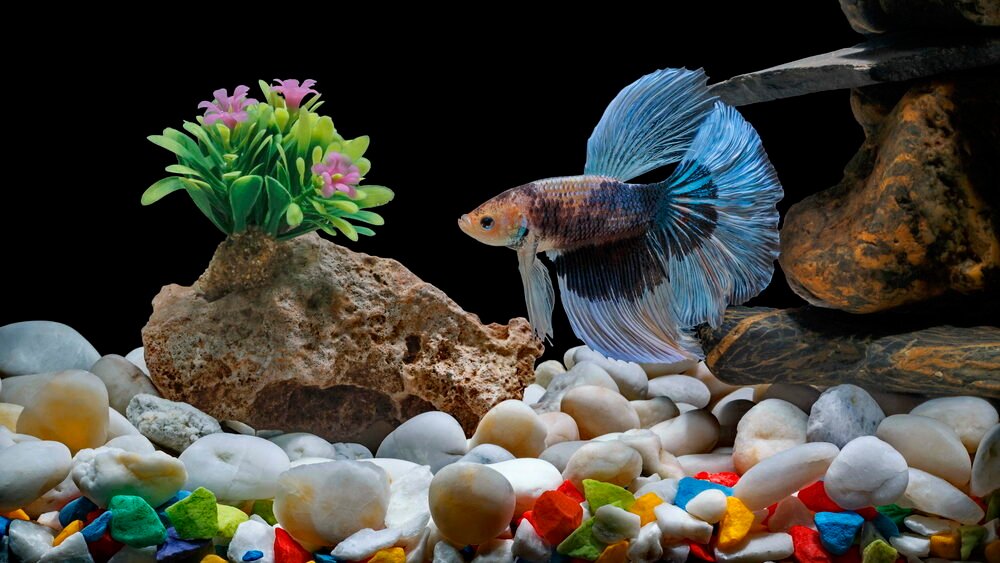How to Treat Swim Bladder Disease in Betta Fish (+ Symptoms & Causes)
Is there anything worse than seeing your beloved pet fish struggling to swim? It may suffer from a swim bladder disease (SBD) if you see it sinking to the bottom, swimming sideways, or flipping over.
Swim bladder disease (SBD) in betta fish can be a real pain in the fin, but don’t despair! With the right approach, you can help your finned friend recover and get back to swimming like a champ.
But don’t panic just yet! SBD can be severe for fish and a real pain in the fin, but you can manage and treat it with the right know-how.
In this article, we’ll examine the topic of swim bladder disease in betta fish, what causes it, and how your betta fish can get back to swimming like a champ. So, let’s dive in.
What Swim Bladder Disease is

The swim bladder is a small, air-filled organ located in the abdomen of your fish. The swim bladder’s function is to help the fish stay afloat in the water (maintain buoyancy) without exerting much energy. With a well-working swim bladder, it acts as a balloon that the fish can inflate or deflate and thereby swim up and down easily.
When the fish has a swim bladder disease, their swim bladder may not function properly, and they can have problems swimming or controlling their swim bladder.
Swim Bladder Disease Symptoms

SBD symptoms can manifest themselves in many ways, and here are some of the most common symptoms of a betta fish suffering from swim bladder disease:
- Difficulty swimming: Any signs that the fish struggle to swim upright, have difficulty keeping their position or depth in the water, or swim in circles.
- Swimming sideways or flipping over: Is the fish swimming at an angle, tilting its face downward, flipping over, or having trouble staying afloat?
- Sinking to the bottom of the tank: If the fish keeps descending to the bottom and seems to have problems staying afloat.
- Floating at the water’s surface: Is the fish ascending to the water’s surface and seeming to struggle to descend?
- Loss of appetite: If your betta fish stops eating or is eating less than usual, it may have lost its appetite, which can be a sign of illness.
- Bloated appearance: Does the betta seem puffy or more swollen than usual?
- Constipation: Do you notice that your fish is not defecating? It may be constipated.
But don’t worry; SBD is not the end of the world for your betta. With proper treatment, your fish will be back to its old self. But before treating it, we should examine the causes of SBD first.
Causes of swim bladder disease in betta fish

Just like how you would examine the lock on the barn door after the horses escaped, you should try to figure out what may be the reason your fish got sick. So let’s look at some common causes of swim bladder disease:
- Poor water quality
- Overfeeding
- Genetic predisposition to disease
- Injury or deformity
- Infection
- Damaged or blocked swim bladder
- Underlying health issues
Poor water quality can become a problem if your tank water is dirty and you don’t change or filter the water as you should, and it can lead to many health issues for your fish, and swim bladder disease is just one of them. If you are feeding your betta fish too much food or the wrong diet, it can lead to problems with digestion or cause nutritional deficiencies, which can lead to disease.
Some fish are more prone to disease and illness due to their genes, which is not something you can control. The best you can do is to set up the best conditions that reduce the risk of disease and support health. Fish with deformities or who suffer physical injuries are more prone to diseases such as SBD. Infection or inflammation in the swim bladder can be another reason for the betta’s swim bladder disorder. If the betta has a blocked or damaged swim bladder, the blockage can cause damage to the fish’s swim bladder.
But no matter the cause, there are ways to help your betta bounce back. Let’s look at betta care and be hopeful.
Treatment options for swim bladder disease in betta fish
Treatment for swim bladder disease depends on how severe the condition is. Here are a few different approaches you can consider.
Quarantine

If you have several fish or animals in your tank, put your sick fish in quarantine. While quarantine isn’t a magic trick that treats sick fish by itself, it can prevent infectious diseases from spreading to others. When you don’t know why your fish is sick, you don’t want to take risks if the illness is contagious. You also give the sick fish some alone time to rest away from the others with the risk of being stressed by other fish.
By moving your sick betta to a quarantine tank, you protect the tank mates and give yourself some time to figure out what’s happening. Remember that moving a betta to a new tank requires careful and gradual acclimation and adjustment, so it doesn’t get stressed.
Improve the water quality
You can do many things to improve the water quality of your fish tank, but by far, the most important is to perform regular water changes. You can change 25-50% of the water every week.
Get a good filter for your tank that is suitable for its size. A clean and well-maintained filter does a lot to maintain the water quality over time. Checking the pH levels is also important for water quality, and bettas need a neutral pH of around 7.0. Fish are sensitive to acidic or alkaline water, and by monitoring the pH levels, you can fix a problem you may otherwise have been oblivious to.
Overcrowding is another factor that often causes low-quality water. Too many animals, tank mates, and plants in a small tank can make it harder to keep clean and maintain. Many aquarium owners consider a 2.5-gallon tank to be big enough for bettas, but I like to have a 5-gallon tank to give sufficient room for bettas. And if you increase the size by 2.5 gallons of water per extra betta fish, that should be plenty of room to avoid overcrowding.
Overfeeding is another problem that can lead to bad water quality. Sprinkling too much food in the tank that either doesn’t get eaten or more than the fish can digest adequately leads to unnecessary waste and debris in your tank. Giving the right amount of food is better, and if your fish doesn’t eat all the food you give it, you can remove it and adjust your portion sizes.
Another way to improve the water quality is to use a water conditioner that removes harmful chemicals, such as contaminants, chlorine, and heavy metals.
Cleaning the tank is another way to maintain water quality. If you decide to clean the entire tank at once, you should move your fish to another tank. But give your betta enough time to acclimate and adjust. Make the change in habitat as small as possible to avoid temperature shock. Use water from your tank and put it into another tank, and slowly move the fish over using filled bags with water from the tank. Once the tank is cleaned and filled with high-quality water with the proper water conditions, gradually mix the new water with the old water in a plastic bag for over 45 minutes to give the bettas time to adjust. Once the bag water consists primarily of new water and the fish has adapted, you can safely release it into the newly cleaned tank.
Other ways to clean the tank are to remove specific decorations and clean them one at a time before placing them back in the tank and using a gravel vacuum to remove debris from the substrate floor.
Adjusting diet and feeding habits

If your betta fish’s diet is poor, you should change it. A good diet includes protein-rich foods such as pellets, freeze-dried food, flakes, and food they sell at the aquarium store.
The amount you give them also matters. If you feed fish too much food, it leads to more waste. Using a feeding station or feeding ring can reduce the waste by placing the food in the tank at the same spot so it doesn’t drift around, and it makes it easier to remove any food the fish didn’t eat. Also, the bettas have small stomachs and are limited to how much food they can eat in one sitting (or swimming). Feeding twice a day can be a good way to avoid overfeeding.
There are also many types of food that fish should avoid, such as human food. Typical human food has too much fiber, carbohydrates, starch, and spices that may harm your fish or cause digestive problems.
The most important thing is that a proper diet promotes health and well-being and reduces the risk of disease and health issues.
Medication
If your poor little betta friend has a bad case of swim bladder disease, it may require medical intervention. Some medicines can treat infections and reduce inflammation in fish. It would be best if you spoke to a veterinarian for the appropriate treatment, as they are the ones that can diagnose and prescribe the necessary meds.
Surgery
In worst-case scenarios, generally considered a last resort, your beloved fish may need surgery to treat the horrible swim bladder disease. If there are physical obstructions in the bladder causing a blockage, or some physical injury that needs repair, then surgery may be the only option. A fish surgery can be risky and expensive, and general insurance most likely won’t cover it unless you have specific pet insurance for emergency treatment for life-threatening conditions.
Improving water quality, adjusting their diet, and even administering meds (if needed) can all help to get your betta back on track.
And if all else fails, there’s always the nuclear option: surgery. But let’s hope it doesn’t come to that.
Prevention of Swim Bladder Disease in Betta Fish

After you’ve treated your fish, let’s consider the best ways to prevent swim bladder disease in the future as an excellent way to summarize this article.
So, what causes SBD in betta fish? It could be many things, including dirty water, overfeeding, or genetics.
How can you prevent SBD?
- Perform regular water changes
- Maintain the water quality by checking temperature and pH levels and using a conditioner
- Maintain the equipment
- Avoid overfeeding by feeding them less, more frequently and using a feeding station
- Give your betta good quality food
- Avoid overcrowding by giving them enough space
- Keep the tank clean by cleaning decorations and removing waste and contaminants.
- Provide a stress-free environment with friendly tank mates and hiding places for rest.
Conclusion
In conclusion, some things can cause swim bladder disease, but with the proper knowledge and approach, you can manage it and keep your betta fish healthy.
If it’s unlucky and gets a bad case of SBD, it’s not the end of the world. You can treat it; hopefully, your fish will be back to flipping and flopping like their old selves again in no time.
Care, love, and attention go a long way, and if you go the extra mile, your betta may thank you by swimming circles around you (or in their tank)
Frequently Asked Questions about Swim Bladder Disease
Is Swim Bladder Disease Contagious?
No, swim bladder disease is not typically contagious.
What Causes Swim Bladder Disease in Bettas?

Many factors can cause swim bladder disease (SBD) in bettas, including poor water quality, overfeeding, genetic predisposition, physical injuries or deformities, infections, blocked or damaged swim bladders, and underlying health issues or other causes.
How do you cure swim bladder disease in betta fish?

Swim bladder disease treatment may involve:
Improving water quality.
Adjusting the diet and feeding habits.
Providing medications or supplements.
Correcting any physical deformities or injuries through surgery.
What is Swim Bladder Disease?
Swim bladder disease (SBD) is a condition that affects the swim bladder’s function and the fish’s ability to maintain buoyancy.
What is Swim Bladder Disease Symptoms?

Typical SBD symptoms are:
Difficulty swimming.
Swimming at an angle or flipping over.
Sinking to the bottom of the tank.
Floating at the surface of the water.
Loss of appetite.
A bloated appearance.
Is Swim Bladder Disease Fatal To Bettas?
In severe cases, swim bladder disease can be fatal, but many can recover from swim bladder disease with proper treatment.
Why Is My Betta Fish Swimming Sideways?

Fish swimming sideways may be due to swim bladder disease, infections, physical injuries, deformities, or underlying health issues. Consult a vetenarian for a diogniosis.

